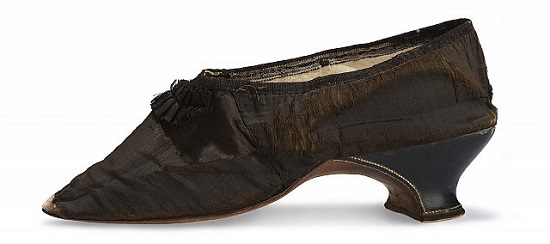Marche et démarche, une histoire de la chaussure

This is the name of a new exhibition by the Musée des Arts Décoratifs in Paris. On display since the 7th of November, the works can be viewed until February 2020
Paris-located Musée des Arts Décoratifs ((Museum of Decorative Arts) is now presenting Marche et démarche, which looks at the form of the shoe. Curated by Dennis Bruna, with exhibition design by the architect and designer Eric Benqué, Marche et démarche will be on view from November 7th November 2019 to the 23rd of February 2020.
The exhibition questions the cultural significance of the shoe, an essential accessory in our daily lives, and explores how the shoe was incorporated into different styles of walking from the Middle Ages to the present day, in both Western and non-European cultures. Marche et démarche will display approximately five-hundred objects, including shoes, paintings, objects d’art, photographs, films and advertisements from public and private collections, offering a unique perspective on how a quotidian object can translate from the ordinary to the extraordinary.
The subject of this exhibition arose from the study of one particular shoe within the museum’s collection, which belonged to Marie-Antoinette in 1792. Measuring just twenty-one centimetres in length and five centimetres in width, it seemed implausible that a thirty-seven-year old woman could have slipped her foot into such a tiny shoe. Research revealed that aristocratic women in the 18th century, and women of the haute bourgeoisie in the 19th century actually walked very little their restricted mobility was such that their shoes were in effect, not made for walking.

Shoe belonging to Marie-Antoinette, 1792
Paris, Musée des Arts Décoratifs
MAD Paris; Photo credits: Christophe Dellière
Paris, Musée des Arts Décoratifs
MAD Paris; Photo credits: Christophe Dellière
The exhibition opens with an analysis of how we walk in our daily lives, from childhood to adulthood, in Europe, Africa, Asia and America. The diversity of forms that shoes can take is surveyed through a study of pieces with flat soles, high heels and platform heels, each of which has a direct impact on the comfort of the shoe.
The cults of small, bound feet in China and constrained feet in seventeenth- and eighteenth-century France are revealed through photographs, mouldings, caricatures and shoes.” A designated “fitting room” space punctuates the exhibition’s circuit with an opportunity for visitors to actively participate: children and adults alike can try walking around in one of eight extraordinary shoe models recreated identically by shoemaker Fred Rolland. The exhibition also looks at footwear for activities such as sport, dance, and military marching. Clown shoes and footwear belonging to Charlie Chaplin are displayed alongside with “magical” shoes, such as the Greek god Hermes’ winged sandals or the folkloric seven-league boots.
Shoe fetishism, represented by the inclusion of elegant leather shoes with vertiginous heels and ultra-high lace up boots, influenced the fantasies of bourgeois nineteenth-century society. Closer to our time, shoes and photographs from 2007 recall the collaboration between Christian Louboutin and David Lynch: the famous shoemaker asked the director to photograph the dancers from the Crazy Horse wearing shoes with exaggerated high heels in a deliberately fetishist context.
The exhibition closes with a selection of contemporary shoes with dramatic, extreme designs in which it is difficult, if not impossible, to walk.













